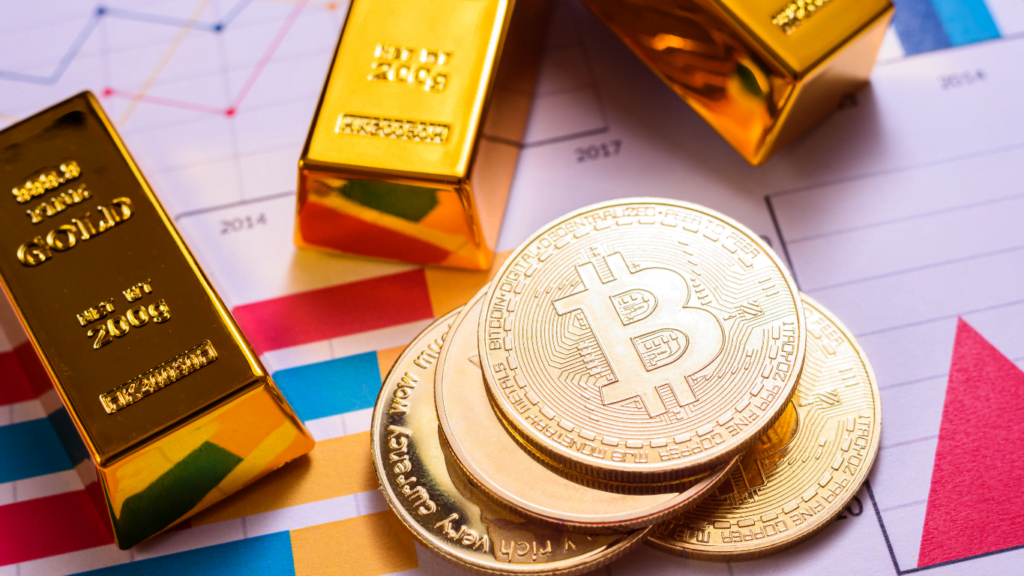
How To Invest In Gold For Beginners: The 5 Best Tips
Posted in :

Ideally, the right investment strategy will attain an optimal equilibrium between risk and profit, especially when considering the opportunity to invest in gold.
Given the numerous developments prompted by COVID19, choosing an effective strategy may seem more daunting than it was previously.
Fortunately many investing techniques have performed well throughout the history, the most famous being gold. It would be nice if you learn how to invest in gold. Investing in this way is usually incredibly complicated.
Nonetheless, gold is an attractive investment for those with enough research and knowledge especially in the present times.

Gold For Beginners
Investing in gold can be a smart financial move, as the precious metal has historically been a store of value and a hedge against inflation.
Here are some tips for investing in gold to help you make the most of your investment:
- Understand the different types of gold investments. There are several options available for investing in gold, including physical gold, exchange-traded funds (ETFs), mining stocks, and gold mutual funds. Each type of investment has its own set of pros and cons, so it’s important to understand the differences before making a decision.
- Consider the costs associated with each type of investment. Physical gold may require storage and insurance fees, while ETFs and mining stocks may have higher management fees. It’s important to factor in these costs when determining your investment strategy.
- Diversify your portfolio. Gold should be just one component of a well-rounded investment portfolio. Diversifying your investments can help reduce your overall risk and increase the chances of achieving your financial goals.
- Do your research. Before investing in any type of gold, it’s important to research the market and understand the current trends. This will help you make informed decisions and increase your chances of success.
- Consider your investment horizon and risk tolerance. The length of time you plan to hold your investment and your risk tolerance will also play a role in determining the best type of gold investment for you. Long-term investments, such as physical gold or mining stocks, may be more suitable for those with a higher risk tolerance, while shorter-term investments, such as ETFs, may be more appropriate for those with a lower risk tolerance.
There are many ways to invest in gold, and each has its pros and cons. While gold investors should weigh each option to determine the best method for their circumstances.
Regardless of the form of gold you choose, most advisors recommend you allocate no more than 10% of your portfolio to it. Any form of investing carries risks.
Gold is no different. But the idiosyncratic gold market isn’t forgiving and takes a long time to learn.
This makes gold ETFs and mutual funds the safest choice for most investors looking to add some of gold’s stability and sparkle to their portfolios.
Here are a few ways to invest in gold:
Gold Coins

You may be familiar with the popularity of gold coins from infomercials and other advertisements.
This form of buying and selling gold is well-known, and often more convenient than gold bars due to their smaller size.
Investors can purchase gold coins from collectors or private dealers, and eventually sell for a profit.
A pawn shop may also sell gold. Note gold’s spot price – the price per ounce right now in the market – as you’re buying, so that you can make a fair deal.
Dealers are located in most cities making gold coins easy to come by. For ease of purchase, gold coins are one of the best ways to invest in gold for beginners.
Gold Mining Companies
You may enjoy the look and feel of physical gold, but you’ll also have to store and insure this precious metal. The return on investment (ROI) with gold depends on the asset’s price rising or falling.
Alternatively, you could invest in a gold mining company or other gold business, so your profits could be based more on the company’s performance rather than the price of gold.
You can buy physical gold in many ways, including via reputable gold dealers, private collectors and pawn shops. The price you pay will depend on the purity of the gold bars.
Bullion is pure gold (99.5% to 99.9%) formed into gold bars or ingots, typically rectangular shapes that allow for easier storage. Central banks often keep gold bullion as a reserve asset, storing it in vaults.
Gold bullion gives investors direct exposure to the price of gold. However, it’s expensive.
Although the diversification reduces risk, it potentially dilutes the impact of rising gold prices.
Meanwhile, gold streaming and royalty companies provide capital to gold miners to develop and expand mines.
They either receive the right to purchase gold at a fixed price (streamers) or a portion of the gold revenue (royalties), reducing their risk compared to gold mining stocks.

Invest In Gold Funds and Gold ETF
If you don’t want the hassle of owning physical gold or dealing with the fast pace and margin requirements of the futures market, then a great alternative is to buy an exchange-traded fund.
Invest in Gold ETFs and Gold Mutual Funds Investing in gold ETFs and mutual funds can provide you with exposure to gold’s long-term stability while offering more liquidity than physical gold and more diversification than individual gold stocks.
There are a range of different types of gold funds. Some are passively managed index funds that track industry trends or the price of bullion using futures or options.
The SPDR Gold Shares ETF ( GLD ), for example, holds physical gold and deposit receipts, and its price tracks the price of physical bullion.
A gold fund is a type of investment fund that commonly holds physical gold bullion, gold futures contracts, or gold mining companies.
There are fees associated with buying and selling gold through ETFs or mutual funds, but they are often much lower when compared to the management of other assets.
Note that ETFs and mutual funds dealing with gold often invest in other commodities as well, meaning you will rarely find a firm that deals strictly with gold.
This can be beneficial if your goal is to diversify, though it may require learning about other markets as well as gold.
- Three of the largest ETFs include SPDR Gold Shares (GLD)
- iShares Gold Trust (IAU)
- Aberdeen Standard Physical Gold Shares ETF (SGOL).
- The goal of ETFs such as these is to match the price performance of gold minus the ETF’s annual expense ratio. The expense ratios on the funds above are only 0.4 percent, 0.25 percent and 0.17 percent, respectively, as of October 2022

IRA Gold Investments
You could set up SEP gold IRAs for yourself and your employees. Beginning investors may benefit by working with a reputable gold IRA company to set everything up to adhere to IRA regulations.
They can help you appoint an IRA-approved custodian and the depository to store the physical gold in your IRA. Learn more about your Gold IRA investment options here.
Gold futures contracts
Gold futures are another way to invest in gold , although it may be too risky for beginning investors due to its speculative nature.
With gold futures, an investor and seller enter into a contract where the buyer agrees to purchase a certain amount of gold at a specific price and date, regardless of market conditions.
That means if you’re holding the investment and the price is dropping just before the contract’s expiration date, you could lose.
Gold futures enjoy more liquidity than physical gold and no management fees, though brokerages may charge a trade fee (also called a commission).

Buying Gold Mining Stocks
If you can’t get your hands directly on any gold, you can always look to gold a mining stock.
Keep in mind however, that gold stocks don’t necessarily move in concert with bullion prices, because mining companies succeed or fail based on their individual operating performance.
By following these tips, you can invest in gold with confidence and potentially reap the benefits of this valuable precious metal.
Whether you’re a seasoned investor or just starting out, investing in gold can be a smart financial move.
Related: Investing in stocks: Best Way To Start
Is Gold A Good Investment?
Gold is a good investment for those looking to diversify their existing portfolios.
The performance of gold is often the opposite of traditional investments like stocks and bonds. When these assets perform negatively, the value of gold generally increases.
Many investors see gold as a good hedge against rising prices and a store of value. It has also historically been a strong hedge during times of financial crisis.
The best times to buy gold are when concerns about inflation or economic crisis are beginning to surface since gold tends to rise during those periods.
Whatever you prefer, be sure you are buying from a reputable dealer, either in person or through the internet .
Gold coins obviously require safekeeping—either a home safe or a bank safe deposit box. Be sure to insure them, too.
From working with pushy salespeople to falling victim to scams, navigating the world of buying and selling gold can be sketchy.
Sellers can inflate their product’s value, or use persuasion tactics to create a sense of urgency to buy immediately. Doing some homework ahead of time can help you avoid these.
Owning Physical Gold. Consider This..
Consider purchasing insurance. Insurance is an additional cost of owning physical gold.
If you purchase insurance, be sure your policy covers the exact type of asset you have. 5. Know your investment is illiquid.
Unlike gold stocks and funds, it may be tough to resell physical gold. Pawnshops aren’t known for their fair pricing.
Conclusion:
It is important to note that investing in gold, like any other investment, carries risk. The value of gold can be affected by a variety of factors, including economic conditions, political events, and market sentiment.
As such, the price of gold can fluctuate and may not perform as well as other investments.
Investing in physical gold also carries additional costs such as storage and insurance.
Additionally, gold mining stocks are subject to additional risks such as operational risks of the company, regulatory risks and natural risks such as natural disasters.
It’s important to conduct thorough research and consult with a financial professional before making any investment decisions.
Diversifying your portfolio and investing only what you can afford to lose is also a good practice.
This post is for informational purposes only and should not be considered as a recommendation or investment advice.
Past performance is not indicative of future results.
When you invest in gold or any other investment carries risk, and investors should carefully consider their own investment objectives, risk tolerance, and financial situation before investing.


